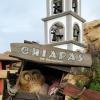10 Years of Afterburn
· JoshC. · 09/30/13 07:40 PM
Unfortunately, Inferno didn't live up to hype. From what I can gather, it's not a particularly highly rated B&M Invert (it's hard for me to judge of course, having only been on two B&M Inverts, but this is based on what I've heard across various forums, and based on the, Mitch Hawker Poll, where it ranked 123rd, if you feel that has some validity) and is seen as a 'good, but not great' ride. It could also suffer from the criticism of it being a 'cookie cutter' B&M, to a degree. So, instead of being a successor to Nemesis, it ended up more being the runt of the two - not that that's a surprise to anyone really.
However, when you wash away the hype, the expectation and the comparisons, Nemesis Inferno is, simply put, a solid, well-rounded ride. It's nothing special, but not everything has to be, and sometimes I think people expect everything to 'be special'. Inferno is easily the park's least-gimmicky major coaster (something which I think is indirectly highlighting on the park's website as well), which, in a way, makes it more appealing to the general public, especially as a 'starter big coaster'.
My first ride came a year after it opened, and in honesty, I don't remember being particularly impressed. Okay, maybe impressed is the wrong word - I did enjoy it and that, but it felt somewhat lacking to me. For various reasons, I rated coasters such as Colossus, Dragon's Fury and Vampire as 'better'. However, as time has gone on, it has improved in leaps and bounds. I think it's safe to say that the ride has aged incredibly well. Like modern B&Ms, it is quite smooth, yet it has aged in such a way that there are a couple of intense moments; specifically the vertical loop. From about 2006 to 2011, it was my favourite coaster at Thorpe, and second favourite I'd been on, which I think does speak for itself. Last year, for some reason, it didn't rank as well with me; I can't quite explain why though. It just 'felt' as if it wasn't as good as I thought it was. It's tenth year, though, it has come into its own. Fast and intense, with the audio and effects really showing that it is a good ride.
As said earlier, some could criticise the ride for being a bit of a 'cookie cutter' B&M, just sticking together some tried and tested elements and creating a decent ride without really doing anything innovative. The pre-lift section is fun, but feels wasted. Unfortunately, the tunnel which it goes through requires the effects (mist and lovely red lights) to be bursting onto you; this is very hit-and-miss. After the near-100ft climb follows the 'standard' drop to the left followed by a forceful vertical loop. A zero-g roll follows; these inversions are quite possibly my favourite inversion, and this one is quick, relentless and unforgiving.
We get a surprisingly low, ground-hugging turn, which takes us into the first of two 'interlocking corkscrews'. Personally, I don't rate the corkscrews; I don't particular feel like they are a worthwhile part to the ride. They feel very bog-standard, and just thrown in because they work on other Inverts. Thing is, the whole 'interlocking corkscrew' thing doesn't exactly shout out to anyone 'Look at me, I'm an exciting ride', yet I almost feel it was designed to have it in mind, and took away from a potentially more interesting element.
Anyway, enough of the negatives. Following the interlocking corkscrews, the ride meanders a little bit into the finale; a figure of eight helix. Whilst the meandering feels a bit unnatural and against the rhythm of the ride, the finale is fun. The best elements of the ride do come in the first half, which makes the second half feel somewhat lacking; a shame really, but I guess that happens in a lot of coasters to be fair.
Theming-wise, the centre-piece volcano is visually striking and impressive. Okay, so what if the other side of it is just a tin-shed; it doesn't actually take away from the appearance, and it just generally is a pointless thing to worry about. There's so many ways money invested in finishing it off could be spent, most of which would be a much better idea. Other than a few bits of rockwork, and long-gone crocodiles hiding in the pools, there's not really any other bits of theming, which is a shame. However, I can't see how much else could effectively have been added to the ride / ride area. Along with the tunnel effects, there are the geysers which sometimes works; always good to watch them when off-ride. What really sells Inferno, though, is the scenery - all of the trees, foliage and so forth makes you feel like you're in some tropical area, and you actually are nearby a real volcano. It just works - perfectly.
So, that's about it really. Inferno is probably Thorpe's most consistently rated coaster; very few people I know of 'dislike' or 'hate' the ride, and the general opinion of it seems quite positive. In a way, that's what's made this blog entry very difficult to write (4 months in the making, on and off), because it's hard to describe the quality of a coaster like Inferno when everyone more or less accepts that quality. However, being 10 years since it opened, I felt like I needed to do it, and had promised to do one following my Saw, well over a year ago...
And I leave you with this:
Feel the heat SNOW. (Taken on 4th April 2013; Inferno's 10th birthday!)
- Read more...
- 1 comment
- 2620 views


